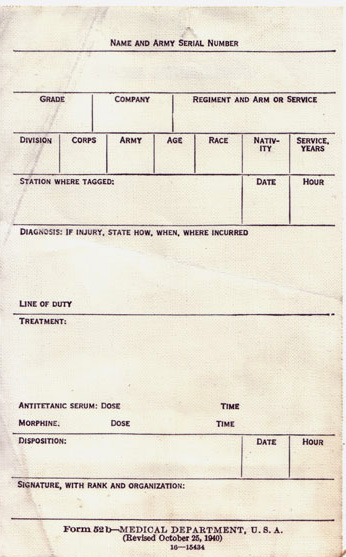The WW2 Emergency Medical Tag

Medic interviewing a wounded soldier and preparing an Emergency Medical Tag …
Background Information:
Besides bandaging, splinting, applying tourniquets, administering sulfa, and injecting morphine, Aidmen were supposed to fill out an Emergency Medical Tag for each casualty. This provided the basic records of the patient’s identity and initial treatment.
During World War 2 every Medic, whether Enlisted Man, Noncommissioned Officer, or Officer, carried an EMT (Emergency Medical Tags) book in one of his canvas pouches. The Tag was attached to the casualty’s clothing, usually over the breast, or as near as possible to it for ease of reading by medical personnel. The Tag would be filled out by the frontline medic and contained data covering the patient’s identity, arm or service, full diagnosis, as well as treatment given, etc. This record helped medical personnel in the rear to know what had been done up front to help the wounded – meanwhile its contents were scrutinized in order to determine further treatment, if necessary. Carbon copies served to compile for the organization commander a daily list of casualties and prepare the necessary reports and keep medical records. When soldiers were killed in action, the EMT attached to the body would be removed by the medical personnel accompanying the burial party from the Graves Registration Service, the Tag would then be forwarded after removing the wire (early issue) or cotton tie (late issue), to the Chief Surgeon who was to transmit same, after recording the contents, to the Surgeon General’s Office. It was recommended to use a medium hard black pencil to complete the Tag, and before writing the cellophane (tissue) paper protector was to be torn out to achieve a good duplicate impression. After preparation, the carbon papers were discarded, and the duplicate copies of the EMT assembled by the senior medical officer of each unit for due recording ! This procedure is also explained in AR 40-1025.
It should be further added that in the course of medical care, proper additional entries were to be made on the casualty’s Emergency Medical Tag.
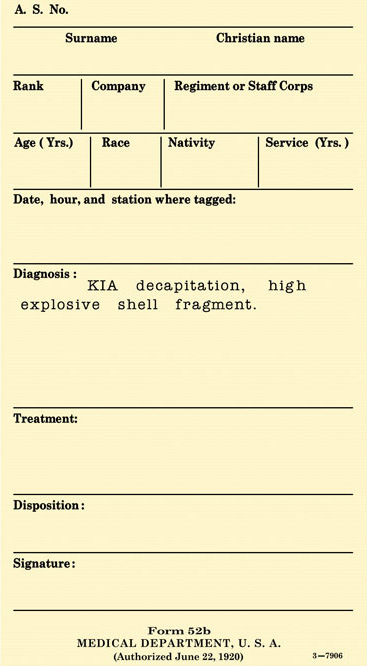
Illustration of Form 52b – Medical Department, U. S. A. (Authorized June 22, 1920) 3-7906, this is a new version authorized and issued during the interbellum years (1920) .
Above illustration shows an early pattern EMT. Entries and type of data to be furnished by Medical Department personnel in this version differ from later issues. The US Government Printing Office reference uses an early code, i.e. 3-7906, with prefix 3 (later replaced by prefix 16). The early pattern as illustrated still appears in a number of pre-WW2 official publications (such as Field and Technical Manuals), while the later version, e.g. Form 52b, Medical Department, U. S. A. (Revised October 25, 1940) 16-15434, makes its appearance during 1942. It should be noted that a number of these ‘early’ Emergency Medical Tags was most probably still in use during the early stages of WW2 (consistent with US Government policy to use existing stocks first).
Remark:
EMTs were further subject to changes throughout WW2 . When looking at an original book and tag, it is to be noted that headings as well as contents and references did vary…
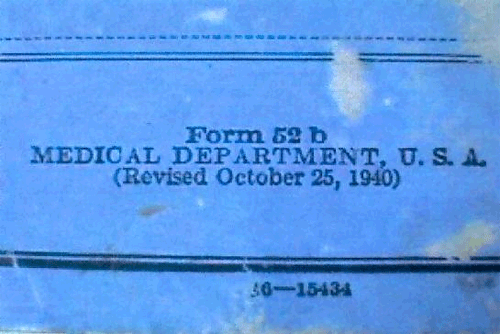
Illustration of Form 52b – Medical Department,U. S. A. (Revised October 25, 1940) 16-15434, this is probably one of the very FIRST EMT issues used in early WW2.
Evolution:
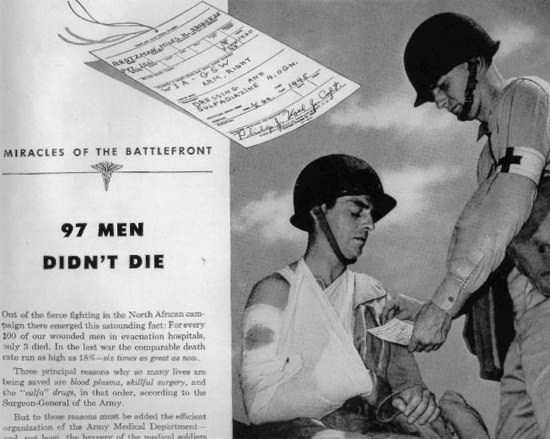
Illustration taken from an ad from ‘Life’ Magazine, Vol. 15, No. 10, dated September 6, 1943
Form 52b–MEDICAL DEPARTMENT, U.S.A. (Revised October 25, 1940), 16-15434 (ad from ‘Life’ Magazine, Vol. 15, No. 10, dated September 6, 1943)
As far as could be determined this sample is probably one of the oldest Tags in use during WW2, it was covered by a blue jacket, while the detachable Tags themselves were printed on light medium brown cardstock material. The blue front cover contains both nomenclature and references e.g. EMERGENCY MEDICAL TAG, U.S. ARMY, a Caduceus, space to write down the name of the medic, and the indication W.D. M.D. Form 52b, date, etc. On the inside of the cover there’s a completely filled-out model to help medics along – the blue rear cover contains full directions on how to use the book, how to complete the tag correctly, what abbreviations to use, while the reverse side is blank. The book further contains 20 x beige tags + brass wire ties (early pattern) with additional spare space on the reverse side indicating Supplemental Record, followed by 20 x carbon sheets, 20 x protective cellophane sheets, 20 x (identical) thin duplicate paper tags (i.e. for record keeping). Main headings to be completed include: Name & Army Serial Number, Grade, Company, Regiment and Arm or Service, Division, Corps, Army, Age, Race, Nativity, Service Years, Station where Tagged, Date, Hour, Diagnosis: if Injury, State How, When, Where Incurred, Line of Duty, Treatment: Antitetanic Serum: Dose + Time, Morphine: Dose + Time, Disposition, Date, Hour, and finally, Signature, with Rank and Organization.
Form 52b-MEDICAL DEPARTMENT, U.S.A. (Revised October 25, 1940), 16-15434 (as illustrated in FM 10-63 Graves Registration, War Department, dated 15 January 1945)
Form 52b-MEDICAL DEPARTMENT, U.S.A. (Revised November 5, 1942) GPO 16-15434-1 Jacket No. 494689 REG. NO. 6028C D
This is a later version, as can be told by the date, the blue jacket still contains the relevant nomenclature, i.e. EMERGENCY MEDICAL TAG, U.S. ARMY, a Caduceus, necessary space to write down the name of the medic, and the indication Form 52b, date, extra markings, etc. The book contents are identical to the first model, the color of the tags is beige (light medium brown), and former brass wires have been replaced by white cotton ties. Main headings have been slightly altered, whereby the Tag now mentions: Name & Army Serial Number, Grade, Arm or Service, Age, Race, Nativity, Service Years, Location Where Tagged, Date, Hour, under Treatment given there is an additional entry i.e. Tetanus Toxoid: Dose + Time, while with Signature, the word Organization is dropped. The designation GPO 16-15434-1, with hyphenated last digit refers to a later change or modification, i.e. Change 1.
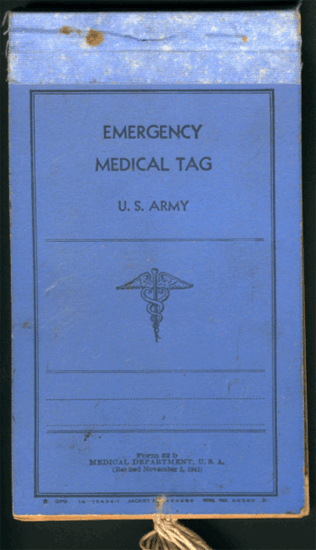
Illustration of above-mentioned Emergency Medical Tag (Change 1)
There is also an apparently amended EMT version, whereby the cover and attached Tags not only show altered texts but are also arranged in a different sequence, such as Form 52b-MEDICAL DEPARTMENT, U.S.A. (Revised November 5, 1942) Arl. 494689-R 6028C GPO 16-15434-1 while this certainly is another Change 1, prefix Arl. and suffix R linked to a sequence of digits still remain unknown?
Emergency Medical Tag (as shown in G.I. Journal, Vol. 1 No. 2, Summer 1996, by J. Gawne stating this sample was taken from the 1944 Medical Instructor’s Guide)
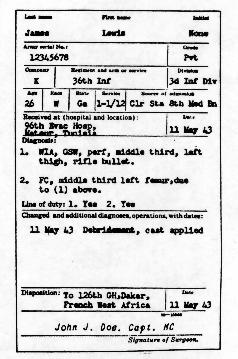
Illustration of another Emergency Medical Tag, as found in The G.I. Journal, page 6
Since this is only a B/W xerox copy, it is hard to assess its color. Furthermore, there is no indication whatsoever covering this EMT (no number, no date, and no book jacket) that could tell us more! Main headings are still there, but in a different order; i.e. Last Name, First Name, Initial, Army Serial No., Grade, Company, Regiment and Arm or Service, Division, Age, Race, State, Service, Source of Admission, Received at (hospital and location), Date, Diagnosis, Line of duty, Changed and Additional Diagnoses, Operations, with dates, Disposition, Date, and Signature of Surgeon.
W.D., A.G.O. Form No. 8-26, 1 October 1944, this form supersedes W.D., M.D. Form No. 52b, 5 November 1942, which may be used until existing stocks are exhausted. 16-15434-2 GPO
This is a slightly modified jacket showing different markings and reference numbers, this is Change 2, also the upper part of the cover bears another marking: Control Approved, Symbol MCS-67, which so far has not been identified…
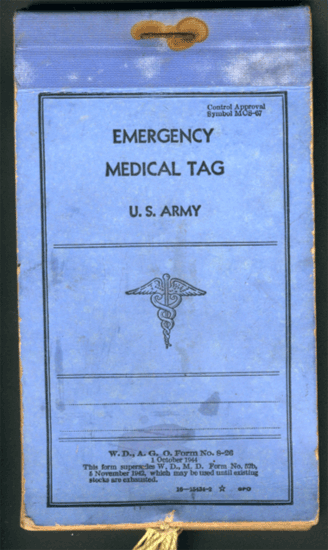
Illustration of above-mentioned Emergency Medical Tag (Change 2)
DA Form (1 Oct 44) 8-26, (Formerly WD AGO). This form supersedes W. D., M. D. Form No. 52B, 5 November 1942, which may be used until existing stocks are exhausted.
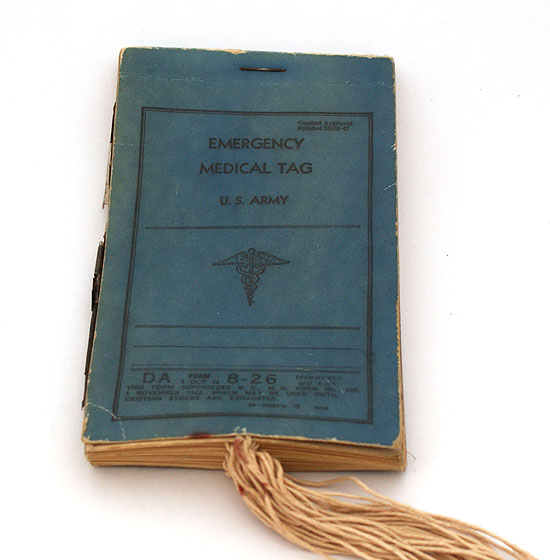
Illustration of above-mentioned Emergency Medical Tag. Note the absence of a material spine on this variant.
This version shows more amendments and 16-15434-2 GPO indicates a Change 2, as we already know that a Change 4 existed, the question then arises, was there a Change 3 ?
In a circular letter dated 1 March 1943, the office of the Chief Surgeon, ETO, APO # 871, issued some new directives when making entries on the Emergency Medical Tag (ref WD MD Form 52b). Section II, War Department Circular No. 182, dated 11 June 1942, rescinded Section IV, Circular No. 50, War Department, dated 1942, and substituted it for the following new directives:
- In combat and simulated combat (maneuvers and field exercises), Aid Stations and Collecting Stations of divisional or brigade units engaged with the enemy will partially accomplish War Department, Medical Department, Form No. 52b to show ONLY name, grade, Army Serial Number, date, hour, diagnosis, and treatment given.
- Form No. 52b, thus partially prepared, will be signed by the person (officer or noncommissioned officer) responsible, indicating his grade.
- At Clearing Stations and other Medical Department establishments in rear of Clearing Stations, Form No. 52b, will be accomplished COMPLETELY;
- Under all conditions of service other than indicated in the first paragraph, Form No. 52, when used will be accomplished COMPLETELY.
Other EMT Versions:
During WW2, President F. D. Roosevelt created the “Office of Civilian Defense” (O.C.D.) by Executive Order No. 8757, dated 20 May 1941. This US Government organization was responsible for the protection of the civilian population, the maintenance of public morale, and the promotion of volunteer involvement in the defense of the United States. There were 9 regional offices tasked with the coordination of Federal, State, and local defense programs for the protection of civilians during enemy air raids and other emergencies. The O.C.D. was closed on 30 June 1945.
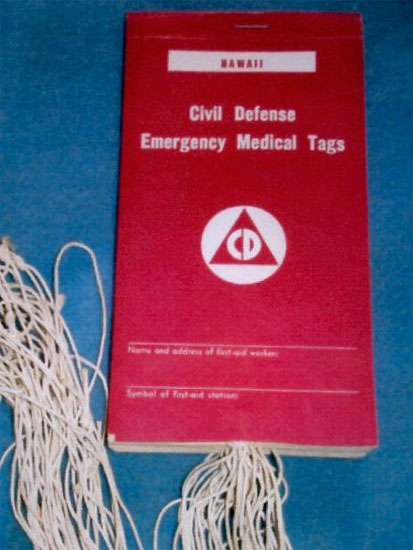
Illustration showing red jacket of O.C.D. EMT Book, used by the organization in Hawaii.
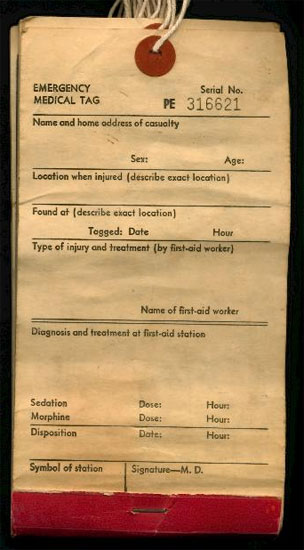
Illustration of O.C.D. EMT Book (missing jacket) showing the obverse side of the Tag.This one belongs to the organization in the State of Pennsylvania.
As these different offices developed and expanded within the Zone of Interior, they not only built their proper organization, insignia, equipment, and provided classes and training, they also introduced the use of Emergency Medical Tags. These Tags also appeared in the form of booklets, just like the ‘military’ issue.
The EMT book is covered by a red jacket, while the detachable tags are printed on light beige cardstock. The red front cover contains the name of the State, the designation Civil Defense Emergency Medical Tags, the logo of the O.C.D. as well as two extra lines for indication of the name and address of the First-Aid worker, and of the Symbol of the First-Aid Station. There is however no Caduceus! Inside this cover (white) are printed directions, with at the bottom the US Government Printing Office reference, such as 16-67619-1 (indicating change 1). The rear cover (white inside, red outside) shows 4 different symbols to be used by the first-aid worker and drawings illustrating 2 different methods for attaching the EMT around the neck or around a limb of the patient. The book further contains 20 x beige tags + white cotton ties with on the reverse side the indication Supplemental Record and a body drawing (front & rear). Each Tag is followed by a carbon sheet, a light yellow protective cellophane sheet, and a thin duplicate paper tag (for record keeping). There are thus in effect 20 pieces of each in every book! Main headings to be completed are: Name & Home Address of Casualty, Sex, Age, Location where Injured, Found at, Tagged: Date & Hour, Type of injury & Treatment, Name of First-Aid Worker, Diagnosis and Treatment at First-Aid Station, Sedation, Dose, Hour, Morphine, Dose, Hour, Symbol of Station, and finally Signature-M.D. The top of the Tag (including duplicate) has following indications: Emergency Medical Tag, Serial No. CA 481440. In this particular case the EMT Booklet was printed by the US Government and issued for use by the State of California, and numbered 481140 (this was the last Tag from a 20 x EMT booklet). States had different prefixes and serial numbers, but retained the red/white jackets (examples: CA 481440 – California, HA 102781 – Hawaii, or PE 316621 – Pennsylvania).
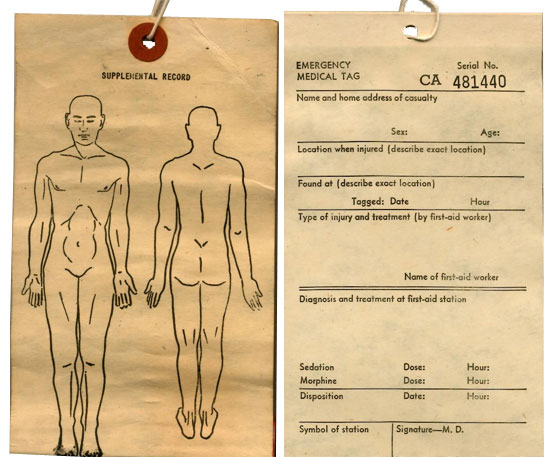
Samples illustrating obverse and reverse sides of O.C.D. Emergency Medical Tags (different issues).
Here is another sample, but designated Identification Tag, unfortunately, this book lost its cover, as well as a number of tags (only 18 left) but the modifications in the headings are noteworthy, also the Tag is a of a more narrow form and made of thick beige cardstock material. This Identification Tag (not designated EMT) has following indications: Identification Tag, followed by Name (Surname), (Given Name), Address, Age, as well as Male-Female-Catholic-Protestant-Jewish-Single-Married-Widowed-White-Negro-Other, Person to be notified: Name, Address, Phone, Relation, Where tagged, Date, 194., Hour, M., Diagnosis: Treatment given:, Morphine, Tourniquet, Where sent, Signed, Organization, and Government reference 16-23481-1. This again, indicates change 1, we can tell it was used in WW2, due to the date indication, i.e. 194. The reverse side (blank) of the tag only carries Supplementary Information, and the eyelet containing the white cotton tie has a brown self-adhesive reinforced ring on the reverse side. There are neither carbon sheets, cellophane protector sheets, nor duplicate paper copies in this book ! Does it mean no more records were necessary? or is there another reason for this modification? So here again, if anybody can help with further identifying the above – any data are most welcome. Another version was also available, with following minor differences: entries look identical, but the Tag is slightly longer, and bears a different reference at the bottom, while it still refers to 16-23481-1 GPO, it now adds Property of U.S. Govt. – O. C. D. i.e. Office of Civilian Defense, which is definitely a Government-run organization, only operating in the continental United States! These booklets are thus not military issue either.

Illustrations of different issues of O.C.D. Identification Tags, not military issue.
The Emergency Veterinary Tag:
The US Army still used animals in certain parts of its organization, requiring a Veterinary Section as in the case of Horse-Drawn or Mounted Units. After collection animal casualties were brought back to the Veterinary Aid Station for treatment. A Noncommissioned Officer remained at the Aid Station at all times; he was responsible for receiving, sorting, and recording casualties and for preparing the necessary EVT Tags. As emergency treatment was given, sick and wounded animals were tagged for classification, indicating diagnosis, possible treatment, etc. just like human beings. Animals were then classified as being sick or wounded and as salvageable or non-salvageable. To enable a decent follow-up, veterinary personnel had to complete an Emergency Veterinary Tag per animal treated. Such Tag was designated Emergency Veterinary Tag, Form 115b, Medical Department, U.S.A., (Revised October 28, 1940). The form consists of three parts, the original, duplicate, and triplicate. The obverse side is always identical and displays the Tag No, Classification, Horse, Mule, Division, Corps, Army, Station where Tagged, Date, Hour, Date Mallein Test, Originated in Service, Antitetanic Serum, Dose, Date, Diagnosis, Complications, Signature, Rank, Organization, and official references. For the original, the reverse side is blank except for the heading Supplemental Record, for the duplicate there are additional headings such as Evacuated to, Date, Final Disposition, Total Days Treatment, Date, Name and Rank. The triplicate is blank and only states Dispositions and Other Notes. Tags are printed on beige cardstock, and provided with wire ties.
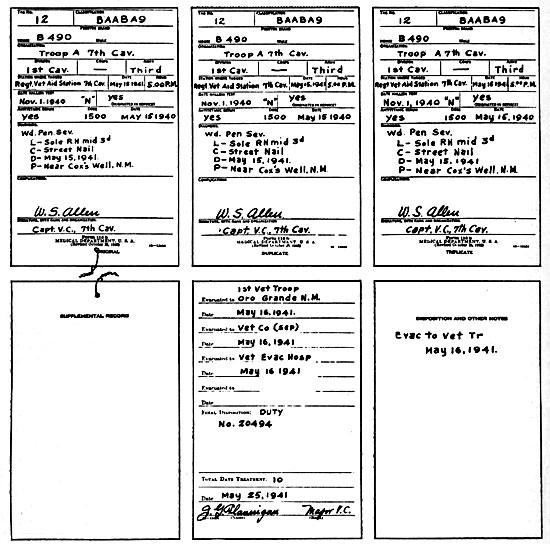
Illustration of Emergency Veterinary Tag, Medical Department Form 115b.
Top shows the obverse side of the EVT (identical for original & copies), while the bottom images illustrate the reverse part of the original, duplicate and triplicate Tags, respectively.
The Clearing Station Tag:
In addition to routine Company Administration, a Clearing Company is concerned with certain Medical records too! Proper entries must be made on the Emergency Medical Tag of every casualty brought to the Clearing Station, and no casualty must leave the Station without one! Additionally Clearing Station Tags are written in order to facilitate the handling of records connected with the admission and disposition of patients. These forms are then consolidated at the station’s office and from them a Station Log or “Check List of Sick and Wounded” is prepared. This Log is preserved by the Company, and from it is prepared a monthly “Casualty Report” (for submission to Battalion Headquarters). The official designation of the Tag is Form 53, Medical Department, U.S.A., (Authorized, May 21, 1942). The two Sections are almost identical, except for the heading ‘Admitted’ on Section A and the word Disposition printed on Section B. Both obverse sections display Name, A S No, Grade, Organization, Diagnosis, Remarks, Disposition, Month, Day, Year, AM, and PM – and Admitted, Month, Day, Year, AM, PM. The reverse side shows the necessary instructions, a number of abbreviations, and directions for use.

Illustration showing obverse and reverse parts of a Clearing Station Tag, Medical Department Form 53.
An individual M.D. Form 53 is initiated for each patient admitted to the Clearing Station. The Tag is composed of two sections, and both are initiated in the ‘Receiving’ department of the Station. An Imprinting Machine (Addressograph M70) is used for printing the necessary information directly from the Identification Tags (aka Dog Tags), the two uppermost lines only, onto the Clearing Station Tag (if such machine is not available, it is done by hand). When Section A is completed, it is torn from Section B and sent to the Clearing Station office. Section B is then attached to a button of the patient’s clothing and remains with him till he reaches the Disposition clerk.
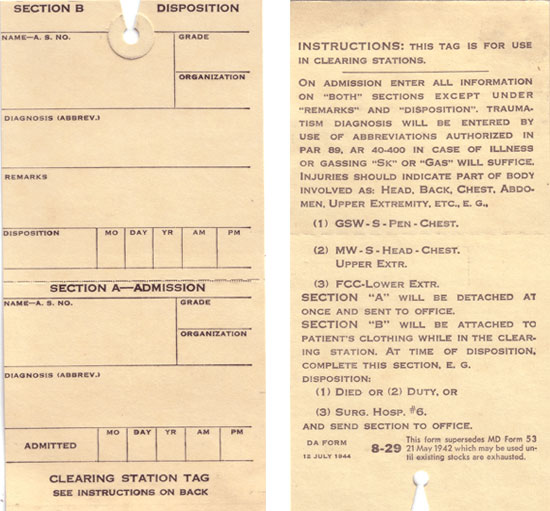
Illustration of Clearing Station Tag, showing both obverse and reverse sides, Medical Department Form 8-29
DA FORM 8-29, 12 July 1944, Clearing Station Tag, this form supersedes MD Form 53, 21 May 1942, which may be used until existing stocks are exhausted – is a later issue of the same form. It equally consists of Section A–Admission (bottom part) with identical headings: Name, A.S. No., Grade, Organization, Diagnosis, Admitted, Mo, Day, Yr, AM, PM and Section B-Disposition (top part). Instructions are indicated on the reverse side of the Tag, including similar abbreviations. Operating procedures are identical for both Forms.
The Evacuation Tag:
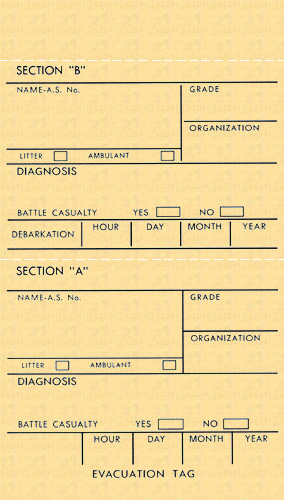
Illustration showing obverse side of an Evacuation Tag (reverse side is blank).
Another Tag, simply designated Evacuation Tag, (no Form or MD reference number) was also used during WW2. It looks quite similar to the Clearing Station Tag, is printed on detachable beige cardstock forms, and consists of two different sections. Section “A” (bottom part) and Section “B” (top part) are almost identical; they indicate Name, A S No, Grade, Organization, Litter, Ambulant, Diagnosis, Battle Casualty, Yes, No, Debarkation, Hour, Day, Month, Year, except for the word Debarkation (omitted in Section “A”). The reverse part is blank, but can be used for extra notes. We have not been able to learn more about this Form, and ignore what organization used it, Aid Station, Collecting Station, Clearing Station, Hospital …? Any help is welcome!
Use of Abbreviations:
Abbreviations of Diagnostic Terms to be used were already included inside the rear cover of the EMT Book. The following number of current abbreviations were covered:
C W Contused Wound; E W Extensive Wound; F U O Fever of Undetermined Origin; F C Fracture, Compound; F C C Fracture, Compound, Comminuted; F S Fracture, Simple; G S W Gun-Shot Wound; I W Incised Wound; K I A Killed In Action; L W Lacerated Wound; M W Multiple Wounds; N Y D Not Yet Diagnosed; Pen W Penetrating Wound; Perf W Perforating Wound; Pun W Punctured Wounds; S V Severe; S Slight; W I A Wounded In Action.
Additional abbreviations of terms were approved by the Adjutant General later in 1944 (also for use in the A & D Reports, Admission/Disposition Reports). They included: A I Accidentally; AS-I Accidentally Self-Inflicted: Amp Amputation; Auto Automobile; B F Bomb Fragment; Cont Contused or Contusions; Disloc Dislocation; F B Foreign Body; G F Grenade Fragment; IS-I Intentionally Self-Inflicted; Lac Lacerated or Lacerations; M F Mine Fragment; Mult Multiple; Pass Passenger; Ped Pedestrian; S F Shell Fragment; Trau Traumatic; W Wound. Nice to know, although not official, is that sometimes the designation E P H was used, meaning Entitled to the Purple Heart, as well as P H N A Purple Heart Not Available/Not Awarded. More abbreviations would be added toward the end of WW2 and postwar … such as BAT Battle; N B Non-Battle; R T D Returned To Duty; R T U Returned To Unit; L W A Lightly Wounded in Action; S W A Seriously Wounded in Action; S I A Seriously Injured in Action; D O W Died of Wounds …

